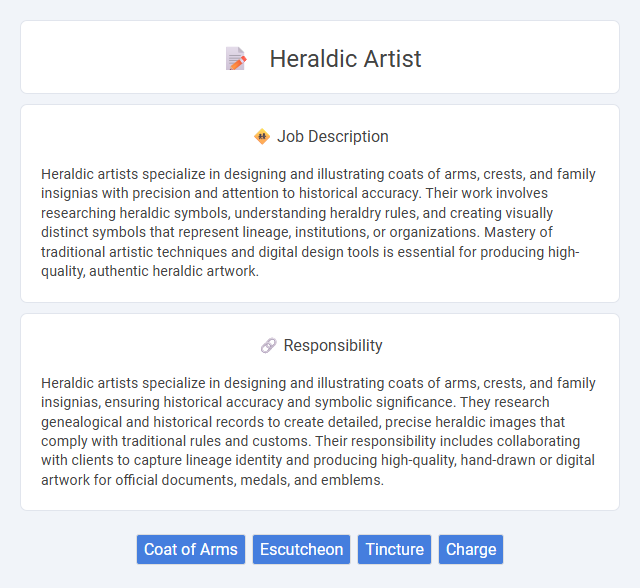
Heraldic artists specialize in designing and illustrating coats of arms, crests, and family insignias with precision and attention to historical accuracy. Their work involves researching heraldic symbols, understanding heraldry rules, and creating visually distinct symbols that represent lineage, institutions, or organizations. Mastery of traditional artistic techniques and digital design tools is essential for producing high-quality, authentic heraldic artwork.
Individuals with a strong passion for history, attention to detail, and artistic skills are likely well-suited for a heraldic artist role. Those who appreciate symbolism, enjoy working independently, and have patience for intricate designs probably find this career fulfilling. However, candidates lacking creativity or an interest in traditional motifs may struggle to engage fully with the demands of the job.
Qualification
A Heraldic artist requires a strong background in fine arts and graphic design, with specialized knowledge in heraldry principles, symbolism, and historical accuracy. Proficiency in digital illustration software, combined with manual drawing skills, enhances the ability to create precise and detailed coats of arms and insignia. Formal qualifications often include a degree or certification in art, design, or heraldic studies, supported by experience in custom emblem creation and manuscript illumination.
Responsibility
Heraldic artists specialize in designing and illustrating coats of arms, crests, and family insignias, ensuring historical accuracy and symbolic significance. They research genealogical and historical records to create detailed, precise heraldic images that comply with traditional rules and customs. Their responsibility includes collaborating with clients to capture lineage identity and producing high-quality, hand-drawn or digital artwork for official documents, medals, and emblems.
Benefit
A career as a heraldic artist likely offers unique opportunities to preserve and create cultural heritage through detailed emblematic designs. This role may provide professional fulfillment by combining artistic skills with historical research, enhancing one's expertise in symbolism and traditional art forms. Working in this specialized field could improve prospects for collaboration with museums, genealogists, and institutions valuing emblematic representation.
Challenge
The role of a heraldic artist likely involves the challenge of accurately interpreting and reproducing complex symbolic designs rooted in historical traditions. Mastery of precise artistry and deep understanding of heraldic rules probably demand continuous learning and attention to detail. Balancing creativity while adhering to strict guidelines may often test the artist's adaptability and skill.
Career Advancement
Heraldic artists specialize in designing and illustrating coats of arms, crests, and emblems, often working closely with genealogists and historians to ensure accuracy. Career advancement opportunities include becoming a lead designer in established firms, specializing in digital heraldry, or transitioning into roles such as art director or consultant for historical societies. Mastery of both traditional hand-drawing techniques and modern graphic software significantly enhances job prospects and opens doors for higher-paying commissions and lecturing positions.
Key Terms
Coat of Arms
A heraldic artist specializes in designing and illustrating Coat of Arms with precise symbolism rooted in historical and cultural significance. Their expertise includes mastering the rules of heraldry, color theory, and iconography to create visually striking and meaningful emblems. The role demands attention to detail, creativity, and knowledge of genealogical and heraldic traditions to produce authentic, custom-designed family or organizational shields.
Escutcheon
Heraldic artists specialize in creating and designing escutcheons, the shield-shaped central element in coats of arms that visually represents family lineage, institutions, or organizations. Precision in symbolism, color schemes, and historically accurate motifs is crucial to ensure authenticity and adherence to heraldic conventions. Mastery of techniques such as tincture rules and geometric composition defines the expert craftsmanship needed for effective escutcheon design.
Tincture
Heraldic artists specialize in creating and restoring coats of arms, with precise attention to tincture, the system of colors and metals used in heraldry. Mastery of tincture rules, such as the proper combination of metals (Or and Argent) and colors (Gules, Azure, Vert, Sable, Purpure), ensures the clarity and symbolism of each design. Accurate rendering of tinctures preserves historical authenticity and enhances the visual impact of heraldic emblems.
Charge
A Heraldic artist specializes in designing and illustrating charges, the symbols or emblems placed on shields in heraldry, ensuring each charge adheres to traditional rules and symbolism. Expertise in interpreting historical and cultural meanings behind charges enables the creation of accurate and meaningful coats of arms. Mastery of techniques in digital and hand-drawn art supports the detailed rendering of charges such as animals, objects, and geometric shapes in vibrant, precise compositions.
 kuljobs.com
kuljobs.com